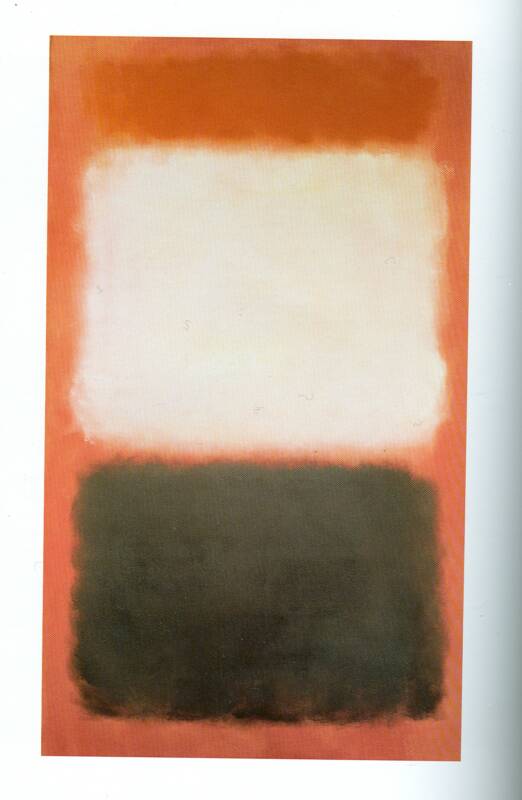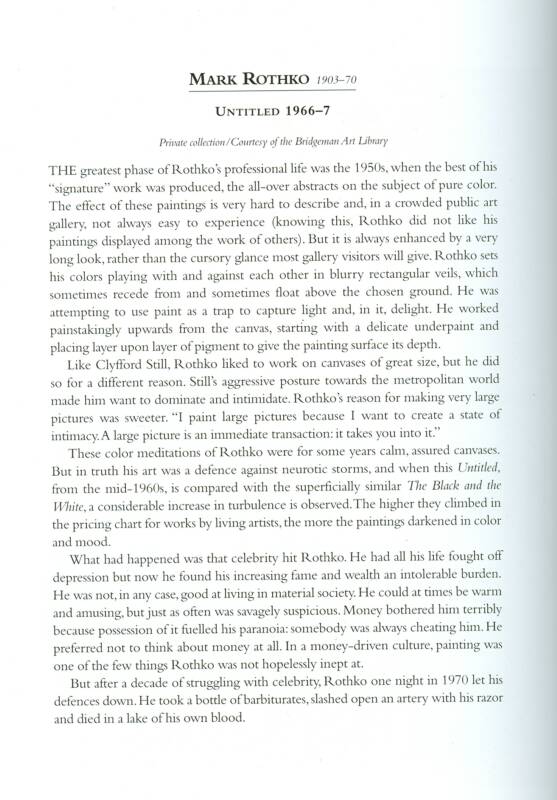Sure celebrity for such petty, bogus artistic productions would be hard to come to grips with since it is such an obvious scam. No wonder he went to the razor. Modern art is the story of how a groupthink art world chose to accept extreme anti-audience, hyper-theoretical art and laud it over the more balanced productions of uninsane naturals. Rothko and the others leave us not with any remotely interesting creations, but with an establishment to demonize. Meaning: whoever pushed this crap on the public was anti-human, anti-intelligence, and ironically anti-art and should be the first to be given the mark of the beast when the Antichrist comes. Socio-racial politics, powerful conformity-enforcer personalities and unintelligible, doublespeak justification rhetoric steeped in specialty lingo straight from the minds of bored and boring hack 'sophistos' make such inversions possible. To summarize the commentary Robin Blake offers on Rothko’s The Black and the White and (above) Untitled: the politics of Rothko’s Jewishness at the time of Hitler meant he felt the horror of the war more intimately than most and in his art this meant Rothko had to express his outrage for humanity by abandoning “the figure.” Rothko circa 1940:
 “It was with the utmost reluctance that I found the figure could not serve my purposes…
“It was with the utmost reluctance that I found the figure could not serve my purposes…
 But the time came when none of us could use the figure without mutilating it.”
But the time came when none of us could use the figure without mutilating it.”
What does he mean by "the figure?" Anything resembling a living being. Observe he opts for the very effective ‘I didn’t want to do it, I had to do it' self-defense strategy, best taken when needing to justify a completely irrational decision, such as when a painter decides to paint blurry squares instead of “figures.” But the commentary inadvertently offers the real reason for the success of the Rothko scam. In a word -- Auschwitz. The horror of Aushwitz, Rothko realized, could make the irrational seem right. As a post-Auschwitz Jew Rothko is uncriticisible, like Hans Christian Andersen's Emperor. Critics sell a sentimentalized post-war America their vision of Rothko with the implied headline - ARTIST (JEWISH) OUTRAGED BY WAR AND DECLINE OF HUMANITY, ABANDONS FIGURE FOR PURE COLOR SHAPES TO SYMBOLIZE WORLD WITHOUT KILLER HUMANS.
Rothko signed a 1943 letter addressed to the New York Times from America’s leading abstract expressionists which reads:
 It is a widely accepted notion among painters that it does not matter what one paints, as long
It is a widely accepted notion among painters that it does not matter what one paints, as long
 as it is well-painted. This is the essence of academicism. There is no such thing as a good
as it is well-painted. This is the essence of academicism. There is no such thing as a good
 painting about nothing. We assert that the subject is crucial and only that subject matter is
painting about nothing. We assert that the subject is crucial and only that subject matter is
 valid which is tragic and timeless. That is why we express a spiritual kinship with primitive
valid which is tragic and timeless. That is why we express a spiritual kinship with primitive
 and archaic art. We favor the simple exression of the complex thought. We are for the large
and archaic art. We favor the simple exression of the complex thought. We are for the large
 shape because it has the impact of the unequivocal. We wish to reassert the picture plane. We
shape because it has the impact of the unequivocal. We wish to reassert the picture plane. We
 are for flat forms because they destroy illusion and reveal truth.
are for flat forms because they destroy illusion and reveal truth.
Complex thoughts are what a painter needs to have when channeling the spiritual kinship of the primitives. Those pre-civilization grunters had heads just full of theory. Reasserting the “picture plane” means eliminating the enjoyment, and that is a dead-end only a hater of art would pursue. Abstract expressionism -- expressing an extreme hatred for art, setting up a universe without humor, a humanoid dystopia with all mystery, all intelligence, all art vacuumed out. In its place shapes, silence, "truth," Hell.
When artists stop seeing themselves as entertainers art is in trouble. Sophistication without honesty spirals into stupidity very quickly in the form of a Rothko or Pollack. An artist must see himself first as an entertainer. To do so is to remain in tune with human psychology. The important difference is not that between art and entertainment, it is the difference between good entertainment and phony pointless entertainment. Artists should defend their unusual productions as better entertainment.
Now don’t think from my dismissive tone I didn’t give these images a good going over with my 20/20 near vision. The glasses came off, I assure you. I studied these images through the microscope of my hot-wired eye-brain duplex. I looked, and I looked again.
But I saw nothing. Only the state of mental emptiness conveyed. There’s all this political theory and forethought (or afterthought), all this context surrounding abstract expressionism, but the work itself is simply empty, so empty in my view as to express a hostility to thought and creativity. If you love thought, you must despise this imagery. He wants the squares to mean something, but that does not mean that they do. Intention, hope - those speculations begin and end in Rothko's psychology. The squares remain silent. In Rothko art becomes the marketing of intentions, not the creation of strangeness and beauty. Suddenly "what is he trying to do?" becomes the key question.
Rothko defenders would say I simply do not understand. Rothko presents pure meaning, "meditations" on color "attempting to use paint as a trap to capture light and, in it, delight." The key word here in my view is attempting. "The effect of these paintings is very hard to describe and, in a crowded public art gallery, not always easy to experience." Notice the assumption that there is an experience to be had, an effect of critical brainwashing. Where critics see ingenious artistic triumph I see only attempt: the attempt to find a gimmick the art world will accept as important originality. I come to these unbrainwashed, assumption-free and I say these images do not inspire thought or wonder or delight, only instant boredom. In other words, this is anti-entertainment -- which I understand is how many (in my view) unsmart people would define art. They are wrong. To strive to entertain and delight is genuinely human. To intentionally bore your fellow humans is fraudulently human and therefore rightly rejected out of love for the possibilities of human beings following their instincts to entertain.
With flat forms Rothko hoped to "destroy illusion and reveal truth." But as the great Nietzsche writes: "the destruction of an illusion does not produce truth but only one more piece of ignorance" (Will to Power, 327). We use art to destroy truth. That's why we invented it. Only a fool would not know when the truth should stop and the lying begin. What an infantile formula. Even an eight-year-old is beyond it: Truth good, illusion bad. Who could not know how violent and ugly the truth can be, and how by confronting violent, ugly truths we ourselves become violent and ugly? Who could not know when to lie, and when to love lying? Art after all, and Rothko's work illustrates the fact as good as any other, comes from people, and though there are exceptions, for the most part the real reason any artistic production lacks worth is because he who made it lacks worth. How's that for truth?
2005 Christopher Duckett


